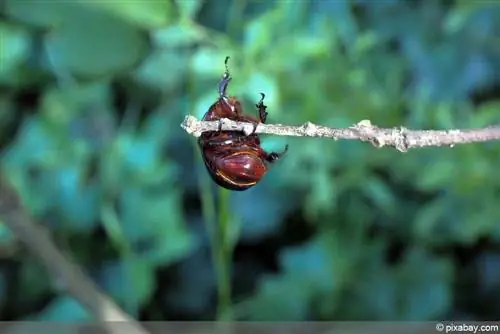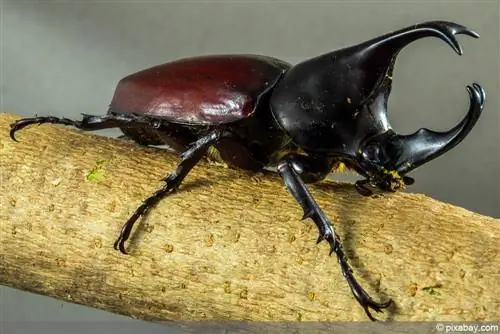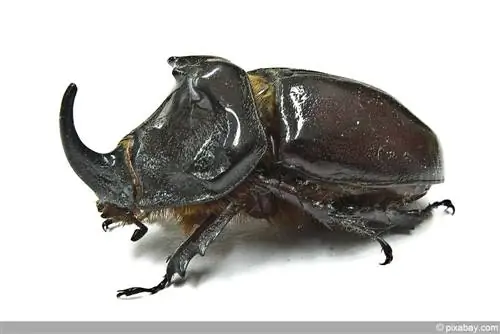- Author admin [email protected].
- Public 2023-12-17 03:39.
- Last modified 2025-01-24 12:45.
It is far from the size of a real rhino, although it reaches considerable dimensions for a beetle in this country. It's always nice to look at: the male rhinoceros beetle. Nature only gives him the nose horn, the female goes away empty-handed. They both support us diligently in the garden. It would be nice to have more of them at home. But how do you do that?
Name and family
The rhinoceros beetle comes from the family of scarab beetles, just like the well-known May beetles and June beetles. However, the related beetle species differ considerably in appearance. The rhinoceros beetles owe their name to the characteristic horn on the top of their heads. This is similar in shape to that of a rhinoceros. Only male specimens are equipped with this, but not necessarily every one. Smaller males can certainly walk without this horn. Disguised as females, they can stay unhindered among real females. In this way they compensate for the physical disadvantage compared to a larger male without having to fight with him using the horn.
Rhino Beetle Profile
- Scientific name: Oryctes nasicornis
- Family: scarab beetle
- Length: 20 to 40 mm long
- Body shape: cylindrical
- Top: black and dark brown
- Elytra: chestnut colored, shiny and smooth
- Underside: red and hairy
- Horn in males: on the top of the head, up to 10 mm long and curved
- Horn in females: on the top of the head, only short or as a hump
- Larvae: cylindrical, large, white
- Development time: about 5 years
- Beetle lifespan: 2-3 months
- Sleeping and waking behavior: active at dusk and at night
Original habitat of rhinoceros beetles
The rhinoceros beetle prefers to feed on wood. When dead wood has already decomposed to the point where it forms a soft mass, it is ideal for the rhinoceros beetle. But a soft mass, the so-called wood mulm, also accumulates in thick branches of deciduous trees. European jungles, where dead trees were allowed to rot largely untouched, used to be the ideal habitat for many species of beetles, including the rhinoceros beetle. There was plenty of food there for him back then. Due to human influence, these forest stands have continued to decline. The deprivation of this livelihood posed a serious threat to many species of beetles. Quite a few species of mulch beetles are threatened with extinction.
The law protects this giant beetle

The rhinoceros beetle has been included in the Federal Species Protection Ordinance in Germany. This has made it a “specially protected” species. Section 44 of the Federal Nature Conservation Act regulates how to deal with it in the wild.
- It is forbidden to catch, injure or kill rhinoceros beetles
- this also applies to their development forms
- Reproductive and resting places must not be damaged
The rhinoceros beetle family also produces some pests, such as the cockchafer. Like the June beetle, this can become a pest and eat trees bare. Therefore, the panic that affects some garden owners when they see beetles and beetle larvae is entirely understandable. Nevertheless, one should not act hastily and possibly use the poison club. First, find out what larvae are involved. If it really is larvae of the harmful beetle species, you should take action. Nevertheless, chemicals do not have to be used, there are some environmentally friendly ways to prevent a plague.
Tip:
If the larvae are particularly large, they could be rhinoceros beetle larvae. They also have the shape of a curved C.
The living space in the garden
Nowadays the rhinoceros beetle can hardly be found in its original habitat, the forest. He has adapted flexibly to the changing living conditions and moved out of the forest to explore new areas. Over time he has, among other things, conquered the garden as his new living space. The ordinary compost heap is his favorite place to stay, as long as he finds fibrous material in it. These can be rotting wooden branches, but also fresh material covered in white rot fungi.
Note:
The life of rhinoceros beetles is short. With a bit of luck, you can see this impressive beetle flying at dusk from June to August.
The reproduction of rhinoceros beetles
Rhinoceros beetles lay eggs, which later develop into new rhinoceros beetles. However, the path from an egg to a beetle is long. This development can take a full five years. During these years, the developing beetle goes through several stages of development. First, larvae hatch from the eggs, which are also called grubs. The larvae grow and shed their skin several times and can eventually reach a length of up to 12 cm. In order for the larva to ultimately become a beetle, it must pupate. The cocoon is of considerable size, often reaching the size of a chicken egg. In order for an egg to develop into a rhinoceros beetle, the breeding site must be left alone for five years. Rhinoceros beetle offspring rarely find these undisturbed conditions in the garden. This is because the rhinoceros beetle lays its eggs in the compost heap. The rotted compost is usually spread into the garden after a year or two.
Note:
The larvae of the rhinoceros beetles initially look very similar to the larvae of the harmful May beetles. However, larvae in the compost heap should not be destroyed. The probability is not small that a rhinoceros beetle will hatch from them.
Natural enemies of the rhinoceros beetle
Like almost every living creature in nature, the rhinoceros beetle also has a natural enemy that seeks its life. For him it is the dagger wasp. It does not directly threaten the adult beetle, but rather attacks its defenseless larvae. She doesn't use this as prey, but rather as a place to lay her own eggs. The wasp egg sticks to the rhinoceros beetle larva and begins to eat away at the outside, piece by piece. This inevitably ends with the death of the larva, from which no more beetles will develop. In particular, the so-called yellow-headed dagger wasp has specialized in rhinoceros beetle larvae.
Promoting rhinoceros beetles in a targeted manner

There are many reasons for specifically settling the rhinoceros beetle and supporting its further development. Species conservation and its usefulness in the garden are two of the reasons. In order to successfully establish the rhinoceros beetle in your own garden, you first need a few specimens of this type of beetle. You may be able to find these in your own garden or buy them specifically. You should also offer him a garden area where there is always enough food waiting for him. A compost heap is wonderfully suitable for this and can be found in almost every kitchen garden. Last but not least, an undisturbed breeding site is necessary so that the offspring can thrive.
Buy rhinoceros beetle
To promote rhinoceros beetles, you first need some live beetles or larvae. If you haven't discovered any rhinoceros beetles in your garden yet, that doesn't mean the end of your project. You are not allowed to search for and remove this protected beetle in the wild. However, rhinoceros beetles are available for purchase. Choose a reputable provider from whom you can get rhino beetles legally.
The ideal compost heap for rhinoceros beetles
The rhinoceros beetles and grubs are actively digging. The compost system should therefore extend at least 20 cm into the soil. They can retreat there even on dry and cold days.
- Put in shredded branches
- Sprinkle sawdust and wood shavings
- Remnants of pressboard are ideal
- Never let the compost heap dry out completely
- let it rest for as long as possible
- Do not turn the compost heap before mid-May
- Sift compost soil through compost sieve, collect larvae
- Transfer larvae to the new compost heap
- Collect beetles and place them on sifted compost soil
Note:
When using chipboard scraps and other pieces of wood, make sure that they are uncoated and do not contain any harmful substances. If in doubt, these do not belong in the compost heap.
Alternative breeding sites
A compost facility is ideal as a habitat and breeding place for the rhinoceros beetle, but not every garden owner can provide such a place. A little help can be given to ensure that the rhinoceros beetles still find a suitable place to live. Set up an artificial pile in a corner of the garden where rhinoceros beetles can find ideal conditions. In this pile you can put the following natural materials:
- Leaves
- Bark mulch
- rotten pieces of wood
- Wood chips
- some horse manure
It is particularly important that you leave this pile undisturbed for many years so that the long development cycle of the rhinoceros beetle is not interrupted prematurely.

